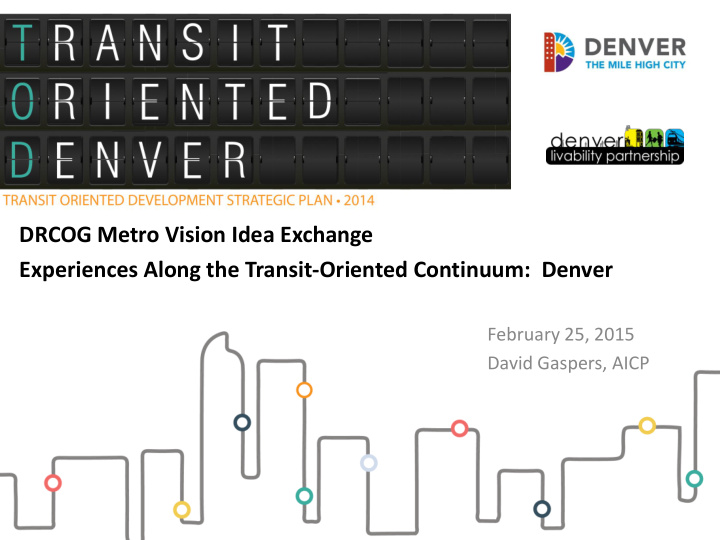



DRCOG Metro Vision Idea Exchange Experiences Along the Transit-Oriented Continuum: Denver February 25, 2015 David Gaspers, AICP
2006 TOD Strategic Plan Long-range planning for 20 + stations New zoning in station areas Established or strengthened external partnerships – DHA, ULC, DRCOG, RTD, etc. TOD Fund established Millions of dollars spent on infrastructure in station areas Collaborated with DURA on TIF opportunities at multiple stations 2
What does the Transit Oriented Denver do? The 2014 TOD Strategic Plan provides a foundation to guide transit oriented development at rail stations through: Creating an implementation action plan for “moving the needle” city-wide high-level policy recommendations Station specific action items Establishing metrics to monitor Denver’s TOD success so the City can continue to refine and improve its strategic moves in the future 4
Transit Oriented Denver narrative focuses on: Moving towards implementation Denver’s foundation for TOD success Connecting and Reconnecting neighborhoods through Transit communities and transit oriented development First and last mile connections
TOD Principles
Foundation for TOD Success
Foundation for TOD Success Directing growth to Station Areas 2013 Permit Data 2013 Permits 2013 Permit Valuation TOD Areas 1,905 $725 million Citywide 9,471 $1.8 billion Percent 20% of permits 40% of permit valuation That is an Investment Per Acre ratio of 5.4 to 1 (TOD Area : Non TOD Area)
Station evaluation (metrics) Market Readiness - Is the market ready for new development? Development Potential - What is the potential capacity for new development? TOD Characteristics – How walkable is the station area? Station categorization Strategize, Catalyze, Energize Action items for each station City-wide policy recommendations
Station Evaluation Market Readiness Screen HH Growth • Commercial Investment • #1 Unimproved Land Value • Property Transactions Development Potential Screen Parcelization • Ownership • Developable Land • #2 Infrastructure Investment • Infrastructure Need Station Categorization
Market Development Readiness Potential Population Growth Adopted Plans Employment Growth Transit-Supportive Zoning TOD Demographics Parcelization Property Values Vacant Land Residential Price Appreciation Redevelopment Land Office Rents Ownership (Owners/Developable Land) Retail Rents District in Place Residential Development Activity ($ of permit value) Infrastructure Investment ($) Commercial Development Infrastructure Needs ($) Activity ($ of permit value)
Station Evaluation
Station Evaluation
Station Categorization The Continuum: Steps to TOD Success Strategize Catalyze Energize Stations with low Stations where the market Stations where both the market readiness is strong but development market readiness and and/or low potential is low or development potential are strong. development potential. development potential is high but the market hasn’t caught up.
Case Study: 38 th & Blake The City’s role in TOD Strategic and collaborative Planning Clear Regulations Strong Partnerships Infrastructure priorities Investment creating tax base and jobs
Case Study: 38 th and Blake Planning 38 th & BLAKE
Case Study: 38 th and Blake Regulations 38 th & BLAKE rea Plan : Yes C-MX-12 I-MX-5 eps Study tructure): Yes tinuum y: Catalyze I-MX-8 : General Urban C-MX-8 C-MX-12 vation
Case Study: 38 th and Blake Partnerships TOD Partnership Opportunities • Urban Land RTD Conservancy • RTD ULC
Case Study: 38 th and Blake Partnerships TOD Partnership Opportunities • Urban Land RTD Conservancy • RTD • Private ULC Developers
Case Study: 38 th and Blake Development Activity
Case Study: 38 th and Blake Development Activity TOD Partnership Opportunities • Urban Land RTD Conservancy • RTD • Private ULC Developers
Case Study: 38 th and Blake Infrastructure Priorities Action Items Infrastructure Prioritization Financing strategies Catalysts
Case Study: 38 th and Blake Infrastructure Priorities
Case Study: 38 th and Blake Infrastructure Priorities
Case Study: 38 th and Blake Infrastructure Priorities Proposed Pedestrian Bridge
Case Study: 38 th and Blake Investment North Denver Cornerstone Collaborative Department of Finance • Financing Plans for Catalyze Stations
Case Study: 38 th and Blake Investment Example of Station Area Fiscal Return Analysis Likely Scenario Office of Economic Bus Market Retail & Residen Personal Allowable Market Bldg Office Services tial Total Real Residential Commeric Property Quadrant Land Height Height Size SqFt SqFt SqFt Prop Value Value al Value Value Development 1 631,600 13 8 2,785,356 1,671,214 139,268 974,875 $ 671,270,796 $ 272,964,888 $ 398,305,908 $ 28,288,772 2 501,000 12 3.5 676,350 0 67,635 608,715 $ 185,319,900 $ 170,440,200 $ 14,879,700 $ 1,056,797 • City Return on 3 583,700 10 4.5 1,287,059 386,118 257,412 643,529 $ 321,764,625 $ 180,188,190 $ 141,576,435 $ 10,055,145 4 366,000 10 6 988,200 691,740 296,460 0 $ 217,404,000 $ - $ 217,404,000 $ 15,440,625 Project Totals 2,082,300 5,736,965 2,749,071 760,775 2,227,119 $ 1,395,759,321 $ 623,593,278 $ 772,166,043 $ 54,841,338 Investment Annual Annual Avg Construct Tax Net Annual Est Annual Total Annual ion Revenu Fiscal Sales Tax Net New Block Value Employment Payroll Wage Fiscal es Benefit Proceeds Sales Tax $ $ 1 699,559,568 5,919 384,727,298 $ 65,000 $ 13,370.0 $ 12,891.6 $ 1,596.5 $ 1,002.7 $ 376.0 $ $ 2 186,376,697 169 5,918,063 35,000 $ 4,967.0 $ 2,035.9 $ (294.5) $ 487.0 $ 182.6 $ $ 3 331,819,770 1,931 86,876,449 45,000 $ 7,222.5 $ 5,124.0 $ 312.9 $ 1,853.4 $ 695.0 $ $ 4 232,844,625 3,047 137,112,750 45,000 $ 3,210.9 $ 5,133.1 $ 1,056.8 $ 2,134.5 $ 800.4 $ $ Totals 1,450,600,659 11,066 614,634,559 $ 55,545 $ 28,770.4 $ 25,184.6 $ 2,671.7 $ 5,477.6 $ 2,054.1 in $1,000 27
Case Study: 38 th & Blake The City’s role in TOD Strategic and collaborative Planning Clear Regulations Strong Partnerships Infrastructure priorities Investment creating tax base and jobs
Project Managers: David Gaspers, CPD david.gaspers@denvergov.org Caryn Champine, CPD caryn.champine@denvergov.org
Recommend
More recommend